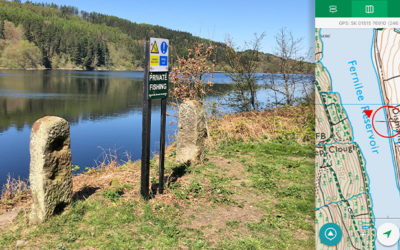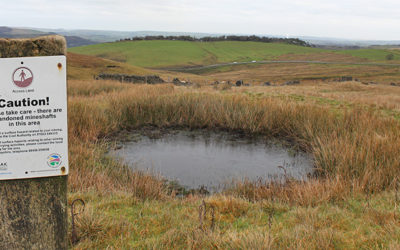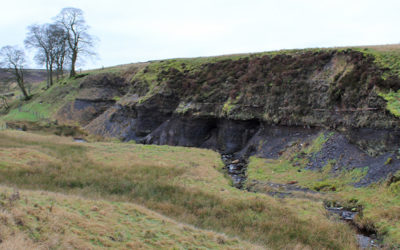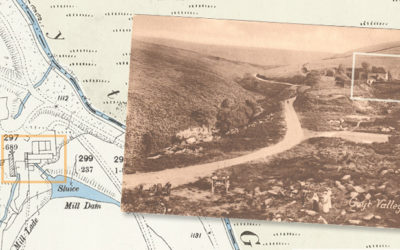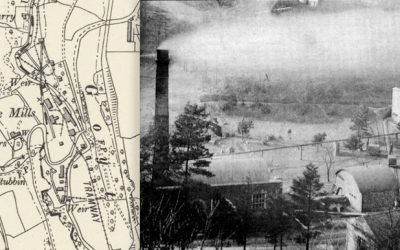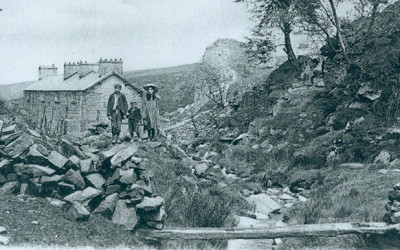
Goyt Valley industries
Today’s visitors to the Goyt Valley enjoy the wonderfully tranquil and picturesque scenery. But it wasn’t always this way. In times gone past the valley rang to the harsh sounds of stone being quarried, coal being mined, steam trains being hauled up and down steep inclines, and even a large gunpowder mill. On these pages I’ll highlight these industries.
Above: An intriguing photo of members of the Chilworth Gunpowder Mill Band. The mill was a major source of employment in the area, but now lies forgotten beneath the waters of Fernilee Reservoir.
Boothman’s Cottages
A photo of a derelict building known as Boothman’s Cottages recently came to light. There’s nothing left of it today. Was it connected to coal mining, or simply a stop-off point for weary travellers?
Over the hills
An inquest into a fatal accident on the Cromford & High Peak Railway in 1877 ruled that passengers could no longer be carried on the line. A writer describes one of the last journeys, riding on the ‘Fly’.
To the gunpowder mill
A pair of stone gateposts beside Fernilee Reservoir set me wondering about their history. Old maps reveal that they once stood at the entrance to a path that led down to the old gunpowder mill.
Ladmanlow station
A recent book on the Cromford & High Peak Railway, which once ran through the Goyt Valley, includes a couple of photos of Ladmanlow Station, on the outskirts of Buxton. But does anything remain?
Issue Tor Quarry
A few people on the Goyt Valley Facebook Group have recently mentioned Issue Tor Quarry. Gary said it’s a very eerie place. And Chris thought a hermit had been living living there. So I was curious to take look.
Colliery: then & now
An old OS map reveals a wealth of fascinating detail on what was once a busy colliery on the outskirts of Buxton, where coal was unloaded from tunnels extending as far as Goyt’s Moss, over a mile away.
Goyt colliery
It’s hard to believe today but this quiet spot, beside the Old Macclesfield Road just outside Burbage, was once a busy colliery where coal was unloaded from small boats onto railway wagons.
Goyt’s Moss mines
A 1997 archeological survey traced the history of coal mining at Goyt’s Moss, from surface workings dating back to the early 1700s to deeper shafts using horses to winch coal up from the seam.
Coal mining in the Goyt
Close to the source of the River Goyt, Goyt’s Moss was once the centre of a coal mining industry which fed the Duke of Devonshire’s lime kilns on the slopes above Buxton. It’s a fascinating story…
Goytsclough postcard #2
An even older photo of Goytsclough shows the paint mill ruins in greater detail. It hopefully brings me one step closer to discovering where the giant waterwheel once stood.
Goytsclough postcard #1
An old postcard of Goytsclough provides another small but tantalising clue in the puzzle over the giant waterwheel that once powered both the stone quarry and the later paint mill.
Tracing the mill lade
Walking the lade from Goytsclough to the Goyt was the only way I was going to work out how water seemed to defy gravity to feed the giant waterwheel. It seems appearances can be very deceptive!
Goytsclough waterwheel (1857)
A newspaper article from 1857 includes some wonderful detail about the paint mill at Goytsclough. But also disproves most of my assumptions about the giant waterwheel which once stood here!
Goytsclough waterwheel
Was there once a giant waterwheel at Goytsclough that was reputed to be the second largest in the world? It seems more than a little unlikely, but I’m trying to discover the facts.
The mushroom cloud
“Machinery was twisted into all shapes and huge beams splintered. Pieces of iron had been thrown high up on the hills and one piece of machinery weighing well over a ton was flung into the water.”
Fernilee industries
Chilworth Gunpowder Mill features in this post focussing on the village of Fernilee. It describes an accidental explosion in 1894 which sent a cannon ball half-a-mile, only just missing a herd of cattle!
Goytsclough Paint Mill
The Goytsclough Paint Mills provided employment for around 20 people. Crushed baryte was packed in bags and taken by wagon to be loaded onto the High Peak Railway.
Goytsclough Quarry
Stone from Goytsclough Quarry was used to pave both Regent Street and Oxford Street in London. Today, few signs remain of an industry created in the 17th century by the founder of Pickfords Removals.
Fernilee Powder Mill
“We are sorry to state that an explosion took place at the Powder Mills, at Fernilee, in the stoving house, by which two unfortunate creatures were in one moment deprived of their existence.”
Cromford & High Peak Railway
Opened in 1831, this 33 mile railway connected the Cromford Canal with the Peak Forest Canal in Whaley Bridge and was a triumph of Victorian ingenuity and determination.


